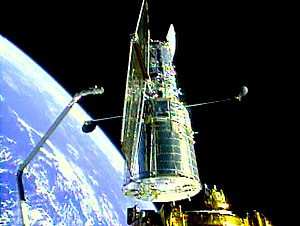Says Robotic Mission Might Take To Long, Won't Work
 Hubble, Hubble, toil and trouble.
The astronomy community has been fuming ever since NASA
Administrator Sean O'Keefe earlier this year announced he would not
send a shuttle to repair the aging Hubble Space Telescope. But
that's just what the National Research Council wants him to do.
Hubble, Hubble, toil and trouble.
The astronomy community has been fuming ever since NASA
Administrator Sean O'Keefe earlier this year announced he would not
send a shuttle to repair the aging Hubble Space Telescope. But
that's just what the National Research Council wants him to do.
In a report commissioned on Capitol Hill, the NRC said it has
little faith in tentative plans for a robotic mission to save
Hubble.
"A shuttle mission is the best option for extending the life of
the Hubble telescope, and ultimately de-orbiting it safely," said
committee Chairman Louis J. Lanzerotti, a consultant for Lucent
Technologies and a professor at the New Jersey Institute of
Technology, in an interview with the South Florida
Sun-Sentinel.
NASA had planned to send a shuttle to change out Hubble's
batteries and prepare it for deorbiting next year. But in January, O'Keefe announced a shuttle
mission to the Hubble would simply be too risky in the wake of
Columbia's break-up almost two years ago.
The robotic mission, which would use a two-armed
robot being developed in Canada. But a lot of
scientists are worried that the robotic mission is too complex and
simply won't work. Others point out that the earliest NASA could
launch a robotic rescue would be 2010. At that point, Hubble
probably won't be up there anymore.
Lanzerotti said his group met with O'Keefe earlier in the week
and that the adminstrator was willing to think about it. "His
comments... were that they would take the report and look at it
very carefully and do an analysis," he told the Sun-Sentinel.
But NASA spokesman Robert Mirelson had a different take on the
meeting. As part of its recommendations -- proposals O'Keefe
promised to accept -- the Columbia Accident Investigation Board
wanted to be sure shuttles could find safe haven at the
International Space Station if something went terribly wrong in
flight. On a Hubble mission, Mirelson told the Ft. Lauderdale
newspaper, there would simply be no such opportunity.
But Lanzerotti counters the ISS option wouldn't be needed -- if
a rescue shuttle was on the pad, ready to go at a moment's
notice.
Former NASA Chief Richard Truly agreed. The retired admiral, a
member of the NRC board chaired by Lanzerotti, said the difference
in risk between flying to the Hubble and flying to the ISS was
"very small."
But even though the NRC committee and an outside contractor
hired by NASA to look at ways to repair the Hubble -- Aerospace
Corp. -- both think a robotic rescue wouldn't be as practical or
efficacious as a shuttle mission, the scientists at Goddard Space
Flight Center would beg to differ. They say the technology is much
more mature than critics have said. Goddard scientists think they
can get a robotic rescue off the ground in just three years.

In the meantime, Hubble continues to orbit the Earth, heaping
discovery upon discovery. Peering far into the universe and deep
into the past, the space telescope earlier this week captured
images of the youngest galaxy on record (above) -- perhaps no
more than 500 million years old as seen from Earth.
 Airborne-Flight Training 05.09.24: ERAU at AIAA, LIFT Diamond Buy, Epic A&P
Airborne-Flight Training 05.09.24: ERAU at AIAA, LIFT Diamond Buy, Epic A&P ANN's Daily Aero-Term (05.07.24): Hazardous Weather Information
ANN's Daily Aero-Term (05.07.24): Hazardous Weather Information Aero-News: Quote of the Day (05.07.24)
Aero-News: Quote of the Day (05.07.24) NTSB Final Report: Cessna 150
NTSB Final Report: Cessna 150 Aero-News: Quote of the Day (05.08.24)
Aero-News: Quote of the Day (05.08.24)




